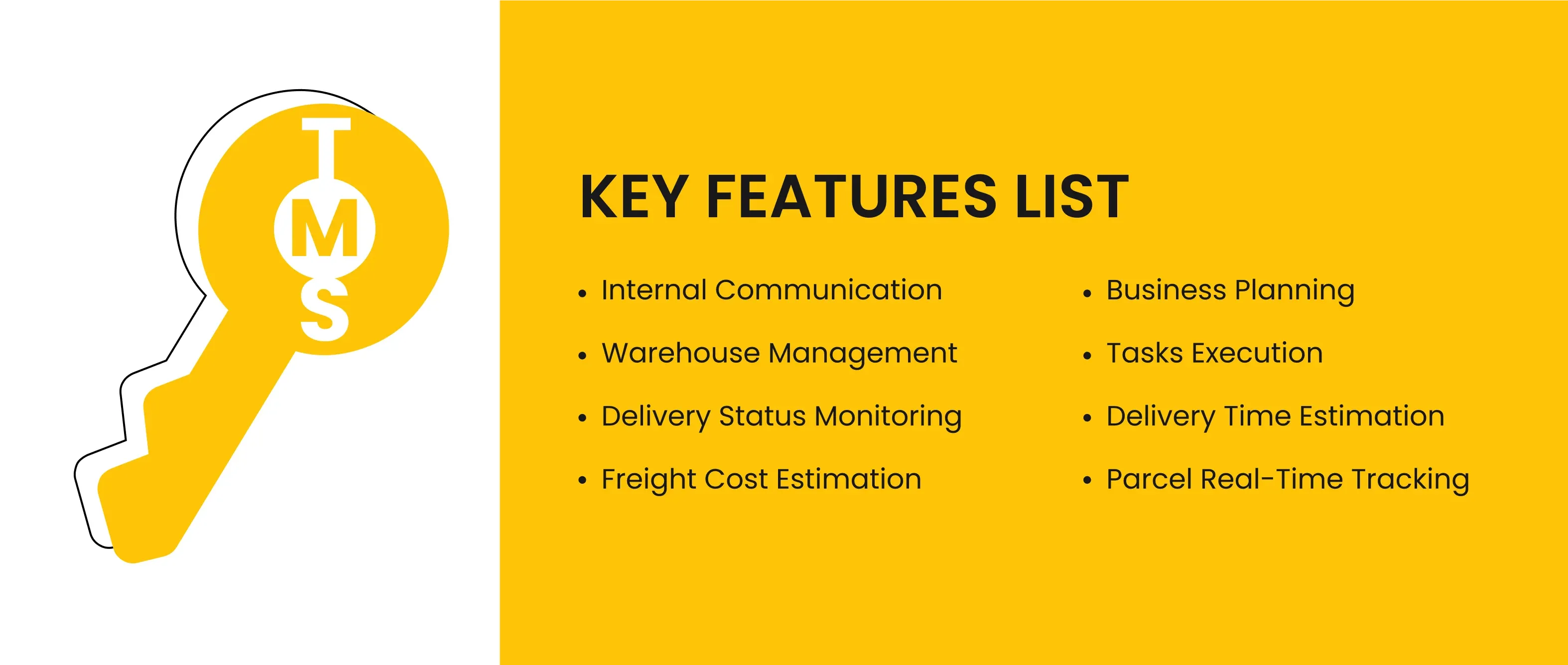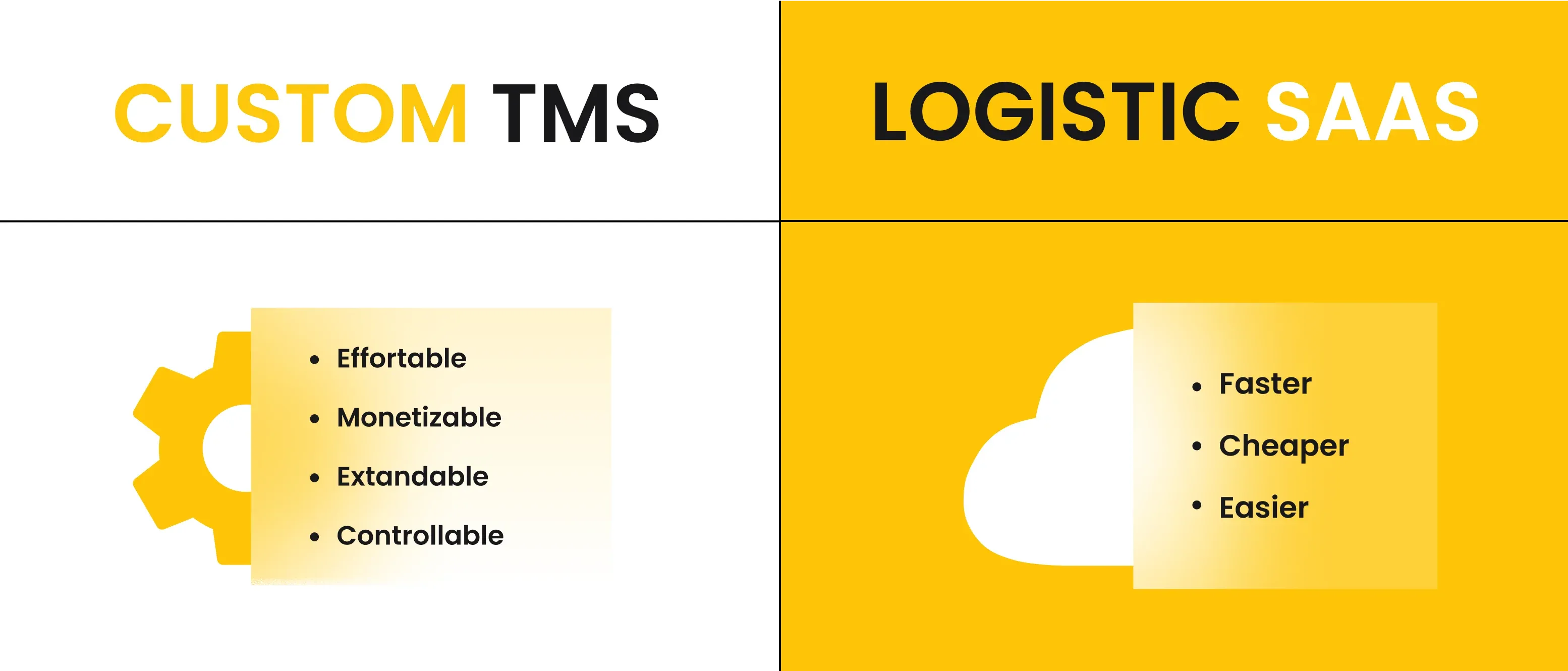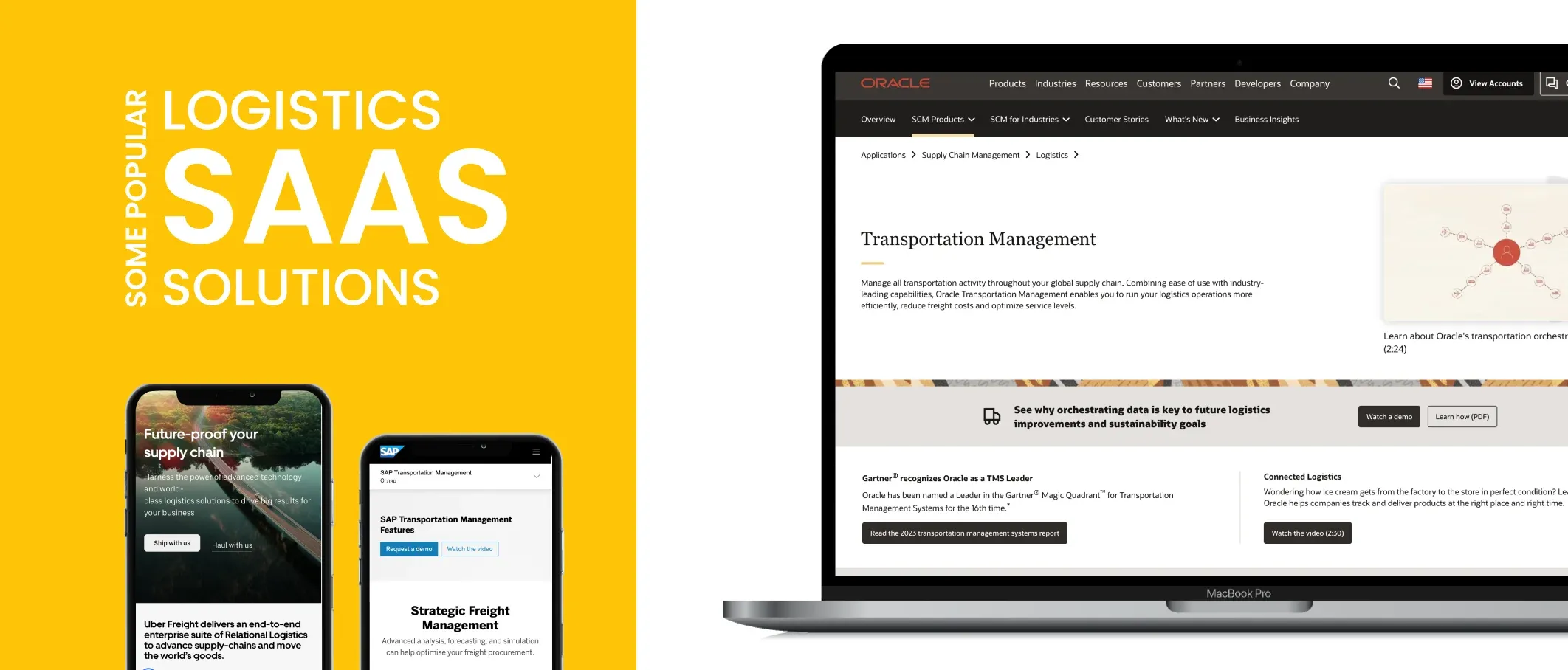Supply Chain
How to Develop a TMS: Real-life Case Study
February 26, 2024 • 300 Views • 17 min read
Tetiana Stoyko
CTO & Co-Founder
Modern software solutions propose numerous advantages and benefits for any industry. This is especially true for supply chains and logistics.
One of the most crucial benefits is the possibility to automate certain routine manual tasks and help manage resources better and track them within an organization.
Judging from our experience, the latest logistics software allows you to significantly boost the efficiency of your transport organization, regardless of its scale: whether it is a small local company, or an international corporation, located in different regions of the world.
For instance, Shipping Flow is a great example of simple and not as famous solutions, designed for large-scale logistics companies, which yet show great efficiency results.
On the one hand, it may lack some very specific and complex functionalities like real-time spending calculations, which include fuel costs, distance changes, etc. Still, the main advantage of this application lies in the fact, that it is document-oriented due to the will of the business owner.
As a result, Shipping Flow proposes real-time data updates on numerous aspects, starting with the actual geolocation of the package and its details, and ending with built-in messenger between employees and advanced analytics, or reporting tools.
Despite the possible small imperfections, the Shipping Flow is a great example of custom TMS solutions, designed to serve the main purposes of small and medium businesses in the Supply Chain industry.
One of the transportation management best practices is to integrate transportation management software, which helps not only to automate certain everyday tasks but also remarkably clarifies the overall view of different ongoing processes and helps to better understand what is going on right now.
However, before talking about the TMS itself, let’s talk about what does transportation management system means, what it looks like, and most importantly, what are the best conditions for such integration into your business.
Transportation Management Systems in a Nutshell

Transportation management system, or TMS, is very similar to any other management software, with the only important difference - it is niche-specific. It means, that the whole system itself is designed to serve specific needs and provide the best possible toolset, particularly for supply chain and logistics management.

To cut a long story short, the transportation management system is a complex software solution, designed to improve business management and track different processes in terms of logistics. Among the key features, it is possible to name:
- Business planning
- Tasks execution
- Delivery time estimation
- Delivery status monitoring
- Parcel real-time tracking
- Internal communication
- Warehouse management
- Freight cost estimation
The preceding is just the most basic features. Some recent TMS solutions also propose numerous extra services, starting with the most optimal route planning and built-in map feature, and ending with complex innovative software like artificial intelligence integration.
Frankly, most such systems already become highly customizable, allowing business owners and employees to adjust them according to their personal needs. The same is true for the functional feature lists: nowadays, it is possible to integrate almost any software solution, regardless of how complex and scalable it is.
To make it simple, it is possible to divide the functionality of such transportation management solutions into a few major groups by core features and use purposes.
Custom TMS Subsystems by Features

Warehouse Management System Features
This segment includes all the functionality, related to warehouse management and item control.
Mainly, these are different inventory management options, which are designed to help track the status of each item at the warehouse, including real-time information updates on received and stored goods, potential shipment tracking, etc.
Also, this includes a wide range of advanced analytics on processes, related to storing, managing, and distributing different products, which aims at saving costs and improving customer service by providing both freight forwarded and clients with information about product availability and the most efficient ways on how and where it should be delivered to save the shipping cost and time to satisfy both parties.
Fleet Management Solutions
Fleet management is the next step of the supply chain.
Such features are mainly designed for transportation companies and their employees, proposing solutions for the most effective transportation operations.
Mainly, they include information on the packages such as the location, where they are stored, and where they should be transported. However, the most important functional components are related to the transportation process itself.
For instance, fleet management helps with transportation planning and related decision-making processes. To do so, they are providing freight forwarders with built-in maps, as well as advanced features for building the most efficient route, which will help with not only delivering packages on time but also with cost savings by cutting the expenses on fuel, road fees, etc.
Documentation and Shipment Details
Finally, another essential feature and one of the main reasons for adopting a Custom Transportation Management System into your everyday supply chain management routine is its data-related solutions.
Clearly, when it comes to any logistics operations, it is always vital to ensure the correctness of information supplements, which include all required data on each package, starting with its description and details, and ending with crucial info for further transport operations and contract management: pickup and delivery places, cargo nature, transportation requirements, declarations, and other documents.
Apart from storing all these types of documents in one place, which boosts customer experience, such technological solutions also significantly speed up the document management process, by automating numerous manual processes related to working with documents, additionally, it also allows for avoiding human factor, which is also extremely important. For instance, it is possible to do so by integrating chatbots or other similar technologies.
Nevertheless, despite the variety of different TMS specifications and niches, it doesn't mean, that your own supply chain management system should include all of the previous features.
Once again, logistics management software should meet your requirements, which may vary depending on countless factors, as well as any other similar software solution. For a better illustration, let's consider some of the real-life case studies, which can help us to understand better what management system development options you have.
Custom Management System vs SaaS Solutions

First things first, we have to define what approach is more suited for you and why. Among the most common practices in any sphere, and the logistics industry is not an exception is to choose between two main options: to develop a custom software application or choose ready-made solutions and services.
SaaS Logistics Service Providers
For example, you can simply decide to choose third-party logistics providers, who will take care of all the major tasks, related to shipping processes. As a result, all you will need - is to pay for the provided services and mind your own business.
Alternatively, you can choose ready-made TMS SaaS, i.e. implement an existing app and use it for your working purposes. Among the advantages of this approach, it is possible to highlight a few major pros:
- It is faster because you don't need to wait for a dedicated team to develop and deliver software solutions,
- It is cheaper due to the fact, that in such cases all you need to pay for - is access to the software, while developing your app requires time and resources not only for the transportation management application development but also to maintain it,
- It is much easier: most SaaS solutions are accompanied by a well-designed User Interface to improve customer satisfaction and user experience.
However, at the same time, it also brings vital drawbacks. For instance, using third-party software always limits your possibilities and won't meet all your requirements. In other words, you simply don't have any control over the built-in functionality and, most likely, will have to look for extra software to cover these limitations.
The reason for it is simple: SaaS software is designed for the most optimal work, commonly being similar to MVP applications, which makes it more manageable and optimized.
Custom Transportation Management Software Development
On the flip side, you can decide to start your development by hiring a dedicated team of software engineers.
As a result, you will at least:
- Have full control over the application, being able to define the key features and extend the functionality whenever you need it,
- Have a chance to save money in the long term, due to the fact, that there are no extra fees or subscription payments, and all your spending is the development and maintenance.
- Get a chance to monetize it in the future by distributing it as a SaaS solution as well.
If we talk about the drawbacks of developing a custom software application for supply chain operations management, it is worth mentioning the fact, that it will take much more time and money until the development stage is done. Besides, you will also need to find a niche-experienced development team, that can create a high-quality product, which might be a difficult task.
Freight Management Case Studies

Eventually, after making an informed decision on which approach to choose, let's also examine some recent cases, to clarify how can your future software product look like. Oracle TMS is probably one of the most well-known examples of such software solutions.
This company proposes an all-in-one management application for the transportation industry, including operation planning instruments, transportation and fleet management, logistics network modeling, and modern solutions like built-in AI and machine learning.
Summing up all the above, it is probably one of the most "complete" TMS cases. It proposes a wide range of various features and services to choose from and covers almost all possible business processes in this field.
SAP Transportation Management is another great example of shipping process management SaaS, that also covers almost the whole business lifecycle, starting with real-time analytics and planning, and ending with supply chain execution monitoring.
Also, it helps with ETA and other calculations for transport companies, which brings a lot of value to the field of transport management and estimation.
Uber Freight is yet another important player in the market of supply chain software and delivery services.
Unlike most Uber Freight alternatives, it proposes a full-fledged service: in addition to transport management software, Uber also provides a ready-made infrastructure with shippers, carriers, and other employees to delegate your transportation work and other manual tasks to others.
In fact, you can use Uber Freight in an extremely user-friendly way with an almost zero-entry threshold, which is a definite advantage in some cases. Still, in such cases, you may also need more analytical instruments and other essential metrics.
TMS Development with Incora
Summing up all the above, the first step is to make an informed decision on what exact approach is the best for your particular situation. You will need to define the required functionality and consider ready-made solutions, whether they meet all your desires. The best way to make the right choice - is to contact a company with some proven experience in this industry and discuss all the options, before making your final decision.
For instance, you can contact us, and we will gladly help you to consider all the pros and cons and choose the most suited option, you will never regret. To prove our point, we propose you check some of our latest case studies and get familiar with our experience in this niche.
What’s your impression after reading this?
Love it!
1
Valuable
1
Exciting
1
Unsatisfied
1
FAQ
Let us address your doubts and clarify key points from the article for better understanding.
What is a Transportation Management System (TMS)?
A Transportation Management System (TMS) is a software solution designed to help organizations effectively manage and optimize their transportation operations. It typically includes features such as route planning, shipment tracking, carrier management, freight auditing, and reporting.
Why do businesses need a TMS?
Businesses need a TMS to streamline their transportation processes, reduce costs, improve efficiency, enhance visibility into their supply chain, and ultimately deliver better service to customers.
What are the key components of a TMS?
Key components of a TMS include:
- Carrier Management: Managing relationships with carriers, including rate negotiation and selection.
- Route Optimization: Finding the most efficient routes for shipments to minimize costs and delivery times.
- Shipment Visibility: Tracking shipments in real-time to provide accurate delivery estimates.
- Warehouse Management Integration: Integrating with warehouse systems to coordinate transportation with inventory levels.
- Billing and Payment: Managing invoices and payments to carriers.
- Reporting and Analytics: Providing insights into transportation performance and cost analysis.
How do I start developing a TMS?
To start developing a TMS, you should:
- Conduct market research to understand the needs of potential users.
- Define the scope and features of your TMS based on market demands and technological capabilities.
- Choose the right technology stack and development tools.
- Design a user-friendly interface for ease of use.
- Develop the core functionalities iteratively, starting with basic features and adding more advanced capabilities over time.
What technologies are commonly used in TMS development?
- Programming Languages: Such as Java, Python, or C# for backend development, and JavaScript or TypeScript for frontend development.
- Databases: SQL or NoSQL databases for storing and managing transportation data.
- APIs: For integrating with third-party systems such as GPS, ERP, or warehouse management systems.
- Cloud Services: Such as AWS, Azure, or Google Cloud for scalability and reliability.
- Machine Learning and AI: For predictive analytics, demand forecasting, and route optimization.
How do I ensure data security in a TMS?
To ensure data security in a TMS, you should:
- Implement encryption to protect sensitive data during transmission and storage.
- Use authentication and authorization mechanisms to control access to the system.
- Regularly update software and patches to address security vulnerabilities.
- Conduct security audits and penetration testing to identify and mitigate potential threats.
- Comply with industry regulations such as GDPR or HIPAA if handling personal or sensitive data.
How can I test and validate my TMS?
To test and validate your TMS, you can:
- Perform unit testing to ensure individual components work as expected.
- Conduct integration testing to verify interactions between different modules.
- Run performance testing to assess system scalability and responsiveness under different loads.
- Use real-world scenarios or simulation tools to validate the effectiveness of route optimization algorithms.
- Gather feedback from users through beta testing or pilot programs to identify areas for improvement.
How long does it take to develop a TMS?
The development timeline for a TMS can vary depending on factors such as the complexity of features, team size, and technology stack. Generally, it may take several months to a year or more to develop and deploy a fully functional TMS.
you may also like
Let’s talk!
This site uses cookies to improve your user experience. Read our Privacy Policy
Accept

Share this article